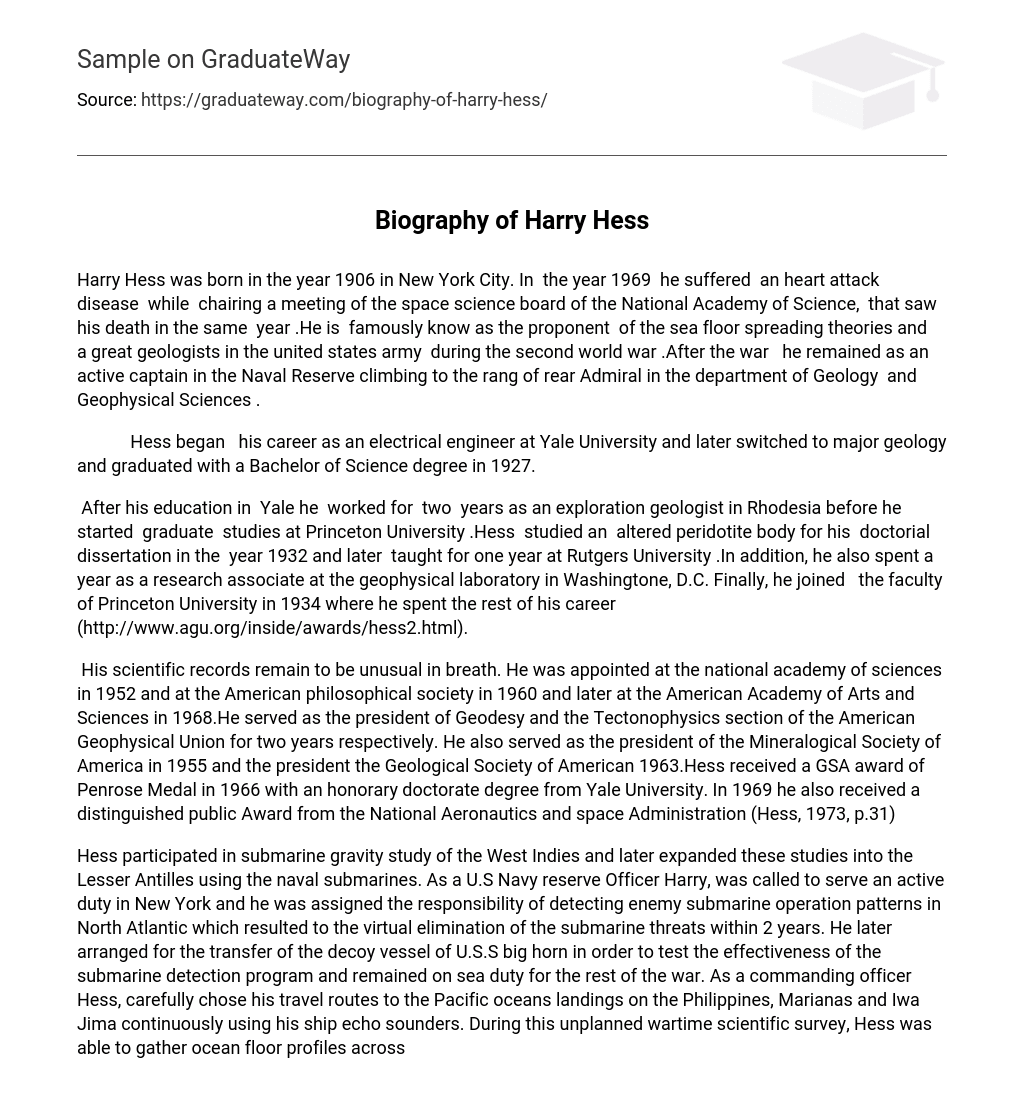Harry Hess was born in the year 1906 in New York City. In the year 1969 he suffered an heart attack disease while chairing a meeting of the space science board of the National Academy of Science, that saw his death in the same year .He is famously know as the proponent of the sea floor spreading theories and a great geologists in the united states army during the second world war .After the war he remained as an active captain in the Naval Reserve climbing to the rang of rear Admiral in the department of Geology and Geophysical Sciences .
Hess began his career as an electrical engineer at Yale University and later switched to major geology and graduated with a Bachelor of Science degree in 1927.
After his education in Yale he worked for two years as an exploration geologist in Rhodesia before he started graduate studies at Princeton University .Hess studied an altered peridotite body for his doctorial dissertation in the year 1932 and later taught for one year at Rutgers University .In addition, he also spent a year as a research associate at the geophysical laboratory in Washingtone, D.C. Finally, he joined the faculty of Princeton University in 1934 where he spent the rest of his career (http://www.agu.org/inside/awards/hess2.html).
His scientific records remain to be unusual in breath. He was appointed at the national academy of sciences in 1952 and at the American philosophical society in 1960 and later at the American Academy of Arts and Sciences in 1968.He served as the president of Geodesy and the Tectonophysics section of the American Geophysical Union for two years respectively. He also served as the president of the Mineralogical Society of America in 1955 and the president the Geological Society of American 1963.Hess received a GSA award of Penrose Medal in 1966 with an honorary doctorate degree from Yale University. In 1969 he also received a distinguished public Award from the National Aeronautics and space Administration (Hess, 1973, p.31)
Hess participated in submarine gravity study of the West Indies and later expanded these studies into the Lesser Antilles using the naval submarines. As a U.S Navy reserve Officer Harry, was called to serve an active duty in New York and he was assigned the responsibility of detecting enemy submarine operation patterns in North Atlantic which resulted to the virtual elimination of the submarine threats within 2 years. He later arranged for the transfer of the decoy vessel of U.S.S big horn in order to test the effectiveness of the submarine detection program and remained on sea duty for the rest of the war. As a commanding officer Hess, carefully chose his travel routes to the Pacific oceans landings on the Philippines, Marianas and Iwa Jima continuously using his ship echo sounders. During this unplanned wartime scientific survey, Hess was able to gather ocean floor profiles across the North Pacific ocean, which resulted to his discovery of the flat – topped submarine volcanoes which he called the “guyots”after the Princeton Geology Building (http://www.agu.org/inside/awards/hess2.html).
One among his many achievements was the publication of his dissertation and two of his papers in the years 1941 and 1960 which were considered as very classic in the study of peridotite complexes. Before his time of death he was designated as the NASAL Principal Investigator for pyroxene studies of recovered lunar samples. Hess reached a point where he could understand the relationship between island arcs, seafloor gravity anomalies and peridotite enabling him to postulate that mantle convection cells were the driving force for seafloor spreading in 1960.He was also a primary proponent of the Mohole Project proposal which was aimed at drilling through the oceanic crust into earth’s mantle.
Harry Hess worked for the scientific community in the fields of geophysics, tectonophysics, geodesy, and mineralogy. For recognition of his leadership the American Geophysical Union decided to establish the HARRY .H HESS Medal for his outstanding achievements in research in the constitution and evolution of Earth and sister planets.
Reference
- Harry Hammond Hess: Biography. Retrieved on 15th October 2008 from http://www.agu.org/inside/awards/hess2.html
- Hess Harry (1973) Studies in Earth and Space Sciences: A Memoir in Honor of Harry Hammond Hess. New York, Geological Society of America





